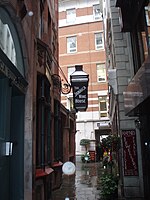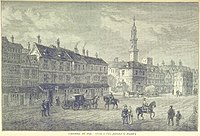Cornhill, London
| Ward of Cornhill | |
|---|---|
 Location within the City | |
Location within Greater London | |
| OS grid reference | TQ327811 |
| Sui generis | |
| Administrative area | Greater London |
| Region | |
| Country | England |
| Sovereign state | United Kingdom |
| Post town | LONDON |
| Postcode district | EC3 |
| Dialling code | 020 |
| Police | City of London |
| Fire | London |
| Ambulance | London |
| UK Parliament | |
| London Assembly | |
Cornhill (formerly also Cornhil) is a ward and street in the City of London, the historic nucleus and financial centre of modern London, England. The street runs between Bank Junction and Leadenhall Street.
The hill from which it takes its name is one of the three ancient hills of London; the others are Tower Hill, site of the Tower of London, and Ludgate Hill, crowned by St Paul's Cathedral. The highest point of Cornhill is at 17.7 metres (58 ft) above sea level.[1]
History

Cornhill is one of the traditional divisions of the City. The street contains two of the City churches designed by Sir
The "Standard" near the junction of Cornhill and Leadenhall Street was the first mechanically pumped public water supply in London, constructed in 1582 on the site of earlier hand-pumped wells and gravity-fed conduits. The mechanism, a force pump driven by a water wheel under the northernmost arch of London Bridge, transferred water from the Thames through lead pipes to four outlets. The service was discontinued in 1603.[2][3] This became the mark from which many distances to and from London were measured and the name still appears on older mileposts (but see also the nearby London Stone and St. Mary-le-Bow church).
In 1652,
The publishers Smith, Elder and Co, based at No. 65, published the popular literary journal The Cornhill Magazine from 1860 to 1975, as well as the Dictionary of National Biography. The magazine was first edited by William Makepeace Thackeray.
Cornhill Street is the address of the "Scrooge and Marley" counting house, the employer of Bob Cratchit, in Charles Dicken's 1843 novella, A Christmas Carol.
Contemporary Cornhill
Today, the street is commonly associated with
Cornhill formed part of the marathon course of the 2012 Olympic and Paralympic Games. The women's Olympic marathon took place on 5 August and the men's Olympic marathon on 12 August. The four Paralympic marathons were held on 9 September.[5][6]
The postcode for the street is EC3V.
Role in City elections
Cornhill is one of 25 wards in the City of London, and each elects an
The current alderman is Robert Howard and the current members of Common Council are Peter Dunphy (Deputy), Joanna Abeyie and Ian Seaton, elected uncontested in 2022.
The most recent Common Council election results, from 23 March 2017, are below:[citation needed]
| Party | Candidate | Votes | % | ±% | |
|---|---|---|---|---|---|
| Labour | Joseph James Batty | 20 | |||
| Independent | Peter Gerard Dunphy | 92 | |||
| Independent | Stephen Decatur Haines | 85 | |||
| Independent | Ian Christopher Norman Seaton | 77 | |||
| Turnout | 29.2 | ||||
-
A drawing of Cornhill in the 1830s. The Royal Exchange is on the left.
-
Cornhill from the air
-
Alley adjacent to St. Michael's
-
Interior of St. Michael's
-
Cornhill in 1630, showing the Royal Exchange and the Water-Conduit, called the Tun
-
Plan showing the extent of the Great Fire in Cornhill in 1748
References
- ^ Ordnance Survey data.
- ^ Timms, John (1855). Curiosities of London, p. 229. David Bogue London. Digital edition from Harvard College library accessed on 2007-11-16.
- ^ Thomson, Richard (1827). The Chronicles of London Bridge, p. 357. Smith Elder and Co, London. Digital edition accessed 2007-11-16.
- ISBN 978-0-09-191857-6.
- ^ "Men's Marathon". Archived from the original on 30 April 2013. Retrieved 30 May 2015.
- ^ "Women's Marathon". Archived from the original on 2 May 2013. Retrieved 30 May 2015.







